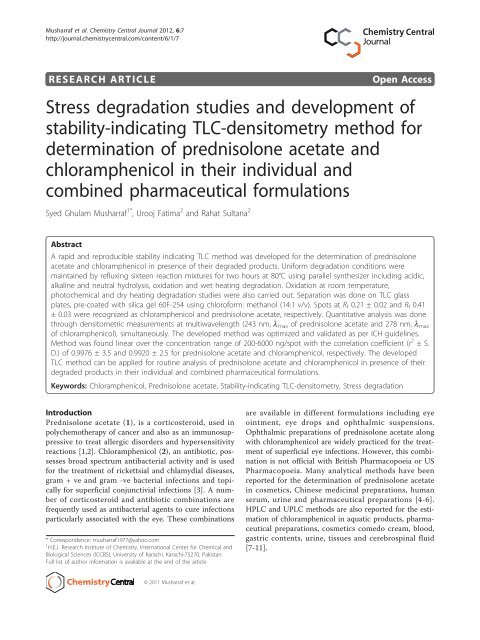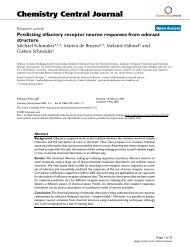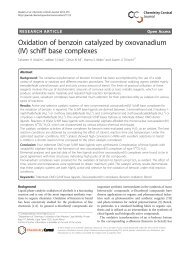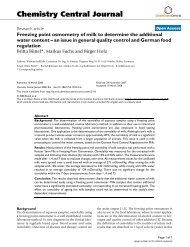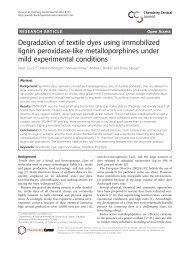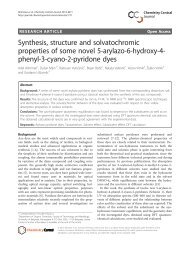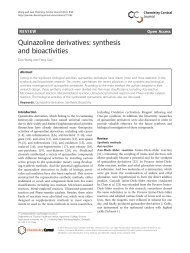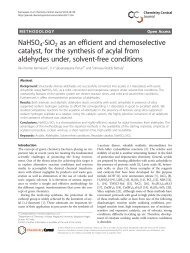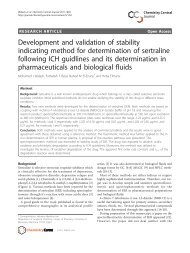Stress degradation studies and development of stability-indicating ...
Stress degradation studies and development of stability-indicating ...
Stress degradation studies and development of stability-indicating ...
You also want an ePaper? Increase the reach of your titles
YUMPU automatically turns print PDFs into web optimized ePapers that Google loves.
Musharraf et al. Chemistry Central Journal 2012, 6:7<br />
http://journal.chemistrycentral.com/content/6/1/7<br />
RESEARCH ARTICLE Open Access<br />
<strong>Stress</strong> <strong>degradation</strong> <strong>studies</strong> <strong>and</strong> <strong>development</strong> <strong>of</strong><br />
<strong>stability</strong>-<strong>indicating</strong> TLC-densitometry method for<br />
determination <strong>of</strong> prednisolone acetate <strong>and</strong><br />
chloramphenicol in their individual <strong>and</strong><br />
combined pharmaceutical formulations<br />
Syed Ghulam Musharraf 1* , Urooj Fatima 2 <strong>and</strong> Rahat Sultana 2<br />
Abstract<br />
A rapid <strong>and</strong> reproducible <strong>stability</strong> <strong>indicating</strong> TLC method was developed for the determination <strong>of</strong> prednisolone<br />
acetate <strong>and</strong> chloramphenicol in presence <strong>of</strong> their degraded products. Uniform <strong>degradation</strong> conditions were<br />
maintained by refluxing sixteen reaction mixtures for two hours at 80°C using parallel synthesizer including acidic,<br />
alkaline <strong>and</strong> neutral hydrolysis, oxidation <strong>and</strong> wet heating <strong>degradation</strong>. Oxidation at room temperature,<br />
photochemical <strong>and</strong> dry heating <strong>degradation</strong> <strong>studies</strong> were also carried out. Separation was done on TLC glass<br />
plates, pre-coated with silica gel 60F-254 using chlor<strong>of</strong>orm: methanol (14:1 v/v). Spots at Rf 0.21 ± 0.02 <strong>and</strong> Rf 0.41<br />
± 0.03 were recognized as chloramphenicol <strong>and</strong> prednisolone acetate, respectively. Quantitative analysis was done<br />
through densitometric measurements at multiwavelength (243 nm, lmax <strong>of</strong> prednisolone acetate <strong>and</strong> 278 nm, lmax <strong>of</strong> chloramphenicol), simultaneously. The developed method was optimized <strong>and</strong> validated as per ICH guidelines.<br />
Method was found linear over the concentration range <strong>of</strong> 200-6000 ng/spot with the correlation coefficient (r 2 ±S.<br />
D.) <strong>of</strong> 0.9976 ± 3.5 <strong>and</strong> 0.9920 ± 2.5 for prednisolone acetate <strong>and</strong> chloramphenicol, respectively. The developed<br />
TLC method can be applied for routine analysis <strong>of</strong> prednisolone acetate <strong>and</strong> chloramphenicol in presence <strong>of</strong> their<br />
degraded products in their individual <strong>and</strong> combined pharmaceutical formulations.<br />
Keywords: Chloramphenicol, Prednisolone acetate, Stability-<strong>indicating</strong> TLC-densitometry, <strong>Stress</strong> <strong>degradation</strong><br />
Introduction<br />
Prednisolone acetate (1), is a corticosteroid, used in<br />
polychemotherapy <strong>of</strong> cancer <strong>and</strong> also as an immunosuppressive<br />
to treat allergic disorders <strong>and</strong> hypersensitivity<br />
reactions [1,2]. Chloramphenicol (2), an antibiotic, possesses<br />
broad spectrum antibacterial activity <strong>and</strong> is used<br />
for the treatment <strong>of</strong> rickettsial <strong>and</strong> chlamydial diseases,<br />
gram + ve <strong>and</strong> gram -ve bacterial infections <strong>and</strong> topically<br />
for superficial conjunctivial infections [3]. A number<br />
<strong>of</strong> corticosteroid <strong>and</strong> antibiotic combinations are<br />
frequently used as antibacterial agents to cure infections<br />
particularly associated with the eye. These combinations<br />
* Correspondence: musharraf1977@yahoo.com<br />
1 H.E.J. Research Institute <strong>of</strong> Chemistry, International Center for Chemical <strong>and</strong><br />
Biological Sciences (ICCBS), University <strong>of</strong> Karachi, Karachi-75270, Pakistan<br />
Full list <strong>of</strong> author information is available at the end <strong>of</strong> the article<br />
© 2011 Musharraf et al;<br />
are available in different formulations including eye<br />
ointment, eye drops <strong>and</strong> ophthalmic suspensions.<br />
Ophthalmic preparations <strong>of</strong> prednisolone acetate along<br />
with chloramphenicol are widely practiced for the treatment<br />
<strong>of</strong> superficial eye infections. However, this combination<br />
is not <strong>of</strong>ficial with British Pharmacopoeia or US<br />
Pharmacopoeia. Many analytical methods have been<br />
reported for the determination <strong>of</strong> prednisolone acetate<br />
in cosmetics, Chinese medicinal preparations, human<br />
serum, urine <strong>and</strong> pharmaceutical preparations [4-6].<br />
HPLC <strong>and</strong> UPLC methods are also reported for the estimation<br />
<strong>of</strong> chloramphenicol in aquatic products, pharmaceutical<br />
preparations, cosmetics comedo cream, blood,<br />
gastric contents, urine, tissues <strong>and</strong> cerebrospinal fluid<br />
[7-11].
Musharraf et al. Chemistry Central Journal 2012, 6:7<br />
http://journal.chemistrycentral.com/content/6/1/7<br />
Simultaneous determination <strong>of</strong> prednisolone, chloramphenicol<br />
<strong>and</strong> a degraded product, 2- amino-1-(4-nitrophenyl)propane-1,3-diol<br />
in ophthalmic solutions<br />
through HPLC is also reported [12]. Few HPTLC methods<br />
have also been reported for the determination <strong>of</strong><br />
chloramphenicol in combination with benzocaine <strong>and</strong> 2amino-1-(4-nitrophenyl)<br />
propane-1,3-diol (ANPD), <strong>and</strong><br />
for different corticosteroids including hydrocortisone,<br />
hydrocortisone acetate, prednisolone, betamethasone-17valerate,<br />
prednisolone sodium phosphate, dexamethasone<br />
sodium phosphate <strong>and</strong> betamethasone sodium<br />
phosphate [13]. No report for the simultaneous determination<br />
<strong>of</strong> prednisolone acetate <strong>and</strong> chloramphenicol in<br />
the presence <strong>of</strong> their degraded products through TLCdensitometry<br />
has been found so far.<br />
Intensive consideration <strong>and</strong> attention is being paid to<br />
the <strong>development</strong> <strong>of</strong> TLC-densitometry <strong>stability</strong>-<strong>indicating</strong><br />
assay as it is fast, reliable <strong>and</strong> accurate <strong>and</strong> involves<br />
simultaneous analysis <strong>of</strong> many samples by using small<br />
quantity <strong>of</strong> mobile phase, thus minimizing analysis time<br />
<strong>and</strong> cost per analysis. <strong>Stress</strong> testing provides evidence<br />
that how the quality <strong>of</strong> a drug substance varies with<br />
time under the influence <strong>of</strong> various environmental factors<br />
(temperature, light, humidity, etc.) <strong>and</strong> helps to<br />
establish shelf life <strong>and</strong> recommended storage conditions<br />
for the drug [14].<br />
Taking ICH guidelines Q1A in consideration, present<br />
studydescribesasimple<strong>and</strong>avalidatedTLC-densitometry<br />
method [15] for the simultaneous determination<br />
<strong>of</strong> prednisolone acetate <strong>and</strong> chloramphenicol in presence<br />
<strong>of</strong> their degraded products formed under the<br />
applied stress conditions. As all the pharmaceutical products<br />
are supposed to be assayed for potency, a validated<br />
TLC-densitometry method, demonstrating no<br />
interferences <strong>of</strong> degraded products with the drug active<br />
components can be useful in measuring these components<br />
in routine analysis.<br />
Experimental<br />
St<strong>and</strong>ards, prednisolone acetate (1) <strong>and</strong> chloramphenicol<br />
(2), (Figure 1), were complementarily provided by Santa<br />
(Pvt.) Ltd, Karachi, Pakistan. Pharmaceutical products<br />
including prednisolone acetate eye drops (P1, Ophtha<br />
Figure 1 Structures <strong>of</strong> prednisolone acetate (1) <strong>and</strong><br />
chloramphenicol (2).<br />
Page 2 <strong>of</strong> 9<br />
Pred,Schazoo;P2,MildoPred,Remington;P3,Predforte,BarretteHodgson;P4,Pred+,Schazoo;P5,<br />
Prens, Vega), chloramphenicol eye drops (C1, spersinicol,<br />
Novartis; C2, chloroptic, Barrette Hodgson) <strong>and</strong><br />
capsule (C3, chlormycetin, Pfizer), <strong>and</strong> ophthalmic suspensions<br />
containing prednisolone acetate <strong>and</strong> chloramphenicol<br />
in combination (PC1, prednisynth, Schazoo;<br />
PC2, prednicol, Remington) along with two expired<br />
pharmaceutical products (EC1, spersinicol, Novartis;<br />
EPC1, prednisynth, Schazoo) were purchased from local<br />
pharmacy shop, Karachi, Pakistan. Methanol <strong>and</strong> chlor<strong>of</strong>orm<br />
<strong>of</strong> analytical grade were purchased from the Fisher<br />
Scientific (UK). Deionized water was obtained from<br />
Millipore Milli Q Plus System (Bedford, USA). Sodium<br />
hydroxide was purchased from BioM Laboratories (Cerritos,<br />
USA) while hydrochloric acid (HCl) <strong>and</strong> hydrogen<br />
peroxide (H 2O 2, 35% v/v) were obtained from Fisher<br />
Scientific (UK).<br />
Instrumentation <strong>and</strong> chromatographic system<br />
<strong>Stress</strong> <strong>degradation</strong> <strong>studies</strong> were performed using parallel<br />
synthesizer (Smart Start Synthesizer, Chem Speed Ltd.,<br />
Switzerl<strong>and</strong>) with sixteen reaction vessels. Planar chromatography<br />
was performed by spotting the sample on<br />
TLC glass plate, pre-coated with silica gel 60F-254 (20 ×<br />
10cm)withtheaid<strong>of</strong>CAMAGmicrolitersamplesyringe<br />
using CAMAG automatic TLC Linomat V applicator<br />
(Muntenz, Switzerl<strong>and</strong>). A constant sample<br />
application rate <strong>of</strong> 0.1 μL/s was adopted <strong>and</strong> the distance<br />
between the two b<strong>and</strong>s was 6 mm. 15 mL <strong>of</strong><br />
mobile phase (chlor<strong>of</strong>orm: methanol, 14:1 v/v) was used<br />
for linear ascending <strong>development</strong> <strong>and</strong> chromatogram<br />
was allowed to move to a distance <strong>of</strong> 8 cm, in twin<br />
trough glass chamber (CAMAG). The chamber saturation<br />
time for mobile phase was 8 minutes at 25 ± 2°C<br />
with relative humidity 42 ± 5%. The developed TLC<br />
plate was dried with the help <strong>of</strong> air dryer for 4 min.<br />
Densitometric scanning was performed on CAMAG<br />
Reprostar scanner III in the reflectance absorbance<br />
mode at multiwavelength (l max, 243nmforprednisolone<br />
acetate <strong>and</strong> l max, 278nmforchloramphenicol)by<br />
utilizing deuterium lamp as the source <strong>of</strong> radiation.<br />
Quantitative evaluation was performed via peak areas by<br />
WinCats s<strong>of</strong>tware (version 1.2.3). Densitometric scanning<br />
parameters were as follows: b<strong>and</strong>width: 10 mm, slit<br />
width: 0.45 mm, slit length: 5 mm, scanning speed: 10<br />
mm/s.<br />
Preparation <strong>of</strong> st<strong>and</strong>ard solutions <strong>and</strong> pharmaceutical<br />
samples<br />
Three stock solutions were prepared by dissolving 100<br />
mg <strong>of</strong> each prednisolone acetate <strong>and</strong> chloramphenicol in<br />
100 mL methanol, individually <strong>and</strong> in combination.<br />
Working st<strong>and</strong>ard solutions were prepared by dilution
Musharraf et al. Chemistry Central Journal 2012, 6:7<br />
http://journal.chemistrycentral.com/content/6/1/7<br />
<strong>of</strong> stock solution with methanol to give solutions in concentration<br />
range <strong>of</strong> 30-1000 μg/mL for calibration curve.<br />
Six-point calibration curve was formed by spotting 6 μL<br />
<strong>of</strong> each st<strong>and</strong>ard solution in concentration range <strong>of</strong> 200-<br />
6000 ng/spot containing both components, each concentration<br />
was spotted thrice on six replicate plates. For<br />
sample preparation, 1 mL ophthalmic samples (P1, P2,<br />
P3 <strong>and</strong> P4) containing 10 mg <strong>of</strong> prednisolone acetate<br />
weredilutedin20mLvolumetricflaskswithmethanol,<br />
separately. Similarly, 1 mL <strong>of</strong> spersinicol <strong>and</strong> chloroptic<br />
containing 0.5% chloramphenicol was diluted in 10 mL<br />
volumetric flasks with methanol. Chloramphenicol capsules,<br />
equivalent to 2500 mg (chlormycetin) were placed<br />
in 500 mL <strong>of</strong> volumetric flask <strong>and</strong> after addition <strong>of</strong> 100<br />
mL water, heated on steam bath till the capsules weredisintegrated.<br />
After further addition <strong>of</strong> 300 mL water, it<br />
was again heated on steam bath with mixing. After cooling<br />
to room temperature, it was diluted to volume with<br />
water. 5 mL <strong>of</strong> the resulting solution was transferred to<br />
100 mL volumetric flask <strong>and</strong> diluted with methanol<br />
[16,17]. 1 mL ophthalmic samples (prednisynth <strong>and</strong> prednicol)<br />
containing 5 mg <strong>of</strong> prednisolone acetate <strong>and</strong> 2<br />
mg chloramphenicol were diluted in 10 mL volumetric<br />
flasks with methanol [4,12]. In similar manner, solutions<br />
for expired spersinicol <strong>and</strong> prednisynth were also prepared<br />
(1 mL in 10 mL volumetric flask). 6 μL <strong>of</strong>each<br />
sample was applied on TLC plate for chromatographic<br />
analysis.<br />
Method validation<br />
The developed method was validated as per the requirements<br />
<strong>of</strong> the ICH guidelines. Linearity was evaluated by<br />
determining six st<strong>and</strong>ard working solutions at a concentration<br />
200-6000 ng/spot. Peak area <strong>and</strong> concentration<br />
was subjected to the least square linear regression equation<br />
to calculate the regression data <strong>and</strong> correlation<br />
coefficients. In order to calculate S/N ratio for LOD <strong>and</strong><br />
LOQ, the formulae used were 3.3 δ/S <strong>and</strong> 10 δ/S,<br />
respectively where δ is the residual error <strong>and</strong> S st<strong>and</strong>s<br />
for slope <strong>of</strong> calibration curve. In order to check the<br />
robustness, following parameters were deliberately changed<br />
within the range <strong>of</strong> ± 5% at three different concentration<br />
levels (200, 400 <strong>and</strong> 800 ng); amount <strong>of</strong> mobile<br />
phase, mobile phase composition, time from spotting to<br />
chromatography, time from chromatography to scanning<br />
<strong>and</strong> chamber saturation time. Intra-day <strong>and</strong> inter-day<br />
precisions were determined with the st<strong>and</strong>ards <strong>and</strong><br />
degraded reaction mixtures. For method repeatability,<br />
assay at three different concentration levels (200, 400<br />
<strong>and</strong> 800 ng) was repeatedly performed six times on the<br />
same day (intra-day). For reproducibility, same samples<br />
at three concentration levels (200, 400 <strong>and</strong> 800 ng) were<br />
analyzed in different days (inter-day) <strong>and</strong> results were<br />
statistically evaluated in terms <strong>of</strong> % R.S.D. For recovery<br />
Page 3 <strong>of</strong> 9<br />
<strong>studies</strong>, pre analyzed pharmaceutical drugs containing<br />
prednisolone acetate (P1), chloramphenicol (C1) <strong>and</strong><br />
both in combination (PC1) were spiked with extra 25,<br />
50 <strong>and</strong> 75% <strong>of</strong> prednisolone acetate <strong>and</strong> chloramphenicol.<br />
The specificity <strong>of</strong> the proposed method was analyzed<br />
by overlapping the densitogram <strong>of</strong> the st<strong>and</strong>ard<br />
<strong>and</strong> samples <strong>and</strong> comparing it at peak start, peak apex<br />
<strong>and</strong> peak end positions.<br />
Preparation <strong>of</strong> forced <strong>degradation</strong> products<br />
Methanolic stock solutions (1 mg/mL) <strong>of</strong> both prednisolone<br />
acetate (set 1) <strong>and</strong> chloramphenicol (set 2) were<br />
prepared, separately <strong>and</strong> in combination (set 3) to perform<br />
forced <strong>degradation</strong> <strong>studies</strong> in parallel synthesizer<br />
by refluxing the reaction mixtures for two hours at 80°<br />
C. After the reactions were completed, all the solutions<br />
were preserved at -80°C till analysis. Average peak areas<br />
<strong>of</strong> active components were analyzed after triplicate<br />
analysis.<br />
For acidic hydrolysis, 1N <strong>and</strong> 5N HCl were used, for<br />
alkaline hydrolysis, 0.1N, 1N <strong>and</strong> 5N NaOH were used<br />
while for neutral hydrolysis Milli Q water was used. 3<br />
mL <strong>of</strong> each concentration <strong>of</strong> acidic <strong>and</strong> alkaline solutions<br />
<strong>and</strong> Milli Q water were added into 3 mL (1 mg/<br />
mL) stock solutions <strong>of</strong> all three sets. To study wet heating<br />
<strong>degradation</strong>, 3 mL (1 mg/mL) <strong>of</strong> stock solution <strong>of</strong><br />
each set 1, set 2 <strong>and</strong> set 3 was subjected to <strong>degradation</strong>.<br />
Oxidation was carried out by adding 1 mL <strong>of</strong> H 2O 2<br />
(35% v/v) in 3 mL stock solution <strong>of</strong> each set. All the<br />
resultant solutions were refluxed for two hours at 80°C<br />
in parallel synthesizer. 1 μL (500ng/spot)<strong>of</strong>1NHCl,<br />
0.5 μL (250ng/spot)<strong>of</strong>5NHCl,4μL (2000 ng/spot) <strong>of</strong><br />
0.1N, 1N <strong>and</strong> 5N NaOH treated solutions, 4 μL (2000<br />
ng/spot) <strong>of</strong> neutral hydrolysis, 6 μL (6000 ng/spot) from<br />
wetheat<strong>degradation</strong>mixture<strong>and</strong>4μL (3000 ng/spot)<br />
from oxidation mixture were applied on TLC plate in<br />
triplicate for chromatographic analysis.<br />
Dry heat <strong>degradation</strong> was conducted by taking st<strong>and</strong>ard<br />
prednisolone acetate <strong>and</strong> chloramphenicol <strong>and</strong><br />
heated in oven at 90°C for 4 hrs. 1 mg <strong>of</strong> each treated<br />
st<strong>and</strong>ard was dissolved in 1 mL <strong>of</strong> methanol <strong>and</strong> 4 μL<br />
(4000 ng/spot) <strong>of</strong> resultant solution <strong>of</strong> each, prednisolone<br />
acetate, chloramphenicol <strong>and</strong> both in combination<br />
was applied on TLC plate in triplicate for chromatographic<br />
analysis. For oxidation reaction at room temperature,<br />
3 mL stock solution <strong>of</strong> each set was added<br />
with 1 mL <strong>of</strong> H 2O 2 (35% v/v) <strong>and</strong> the resultant solutions<br />
were kept for 24 hours at room temperature. 4 μL (3000<br />
ng/spot) <strong>of</strong> each treated solution was applied on TLC<br />
plate in triplicate for chromatographic analysis. In order<br />
to evaluate photochemical <strong>degradation</strong> <strong>of</strong> prednisolone<br />
acetate, chloramphenicol <strong>and</strong> both in combination,<br />
stock solution <strong>of</strong> each set was directly exposed to the<br />
sunlight for three days from 8 to 18 hrs at 30 ± 2°C. 6
Musharraf et al. Chemistry Central Journal 2012, 6:7<br />
http://journal.chemistrycentral.com/content/6/1/7<br />
μL (6000 ng/spot) <strong>of</strong> each treated solution was applied<br />
on TLC plate in triplicate for chromatographic analysis.<br />
Results <strong>and</strong> discussion<br />
Optimization <strong>of</strong> TLC system <strong>and</strong> method validation<br />
With the aim to develop a reliable <strong>stability</strong> <strong>indicating</strong><br />
method, solvent system was optimized with st<strong>and</strong>ards,<br />
samples <strong>and</strong> degraded products. Different solvent systems<br />
<strong>of</strong> 2-propanol, toluene, ether, chlor<strong>of</strong>orm, methanol,<br />
glacial acetic acid <strong>and</strong> acetone were tried in varying<br />
ratios. Solvent systems <strong>and</strong> resulting R f values <strong>of</strong> both<br />
st<strong>and</strong>ards are summarized in Table S1 [see Additional<br />
file 1]. Most <strong>of</strong> the solvent systems showed diffused<br />
spots <strong>of</strong> prednisolone acetate. Suitable separation with<br />
best resolution was achieved with chlor<strong>of</strong>orm: methanol<br />
(14: 1 v/v) which showed sharp b<strong>and</strong>s with R f value <strong>of</strong><br />
chloramphenicol at 0.21 ± 0.02 <strong>and</strong> <strong>of</strong> prednisolone<br />
acetate at 0.41 ± 0.03 (Figure 2).<br />
Figure 2 Chromatogram <strong>of</strong> (a) st<strong>and</strong>ard chloramphenicol at<br />
lmax 278 nm (b) st<strong>and</strong>ard prednisolone acetate at lmax 243<br />
nm (c) st<strong>and</strong>ard prednisolone acetate <strong>and</strong> chloramphenicol in<br />
combination at l 278 nm.<br />
St<strong>and</strong>ard calibration curve for both prednisolone acetate<br />
<strong>and</strong> chloramphenicol in the concentration range <strong>of</strong> 200-<br />
6000 ng was found linear with r 2 ± S.D. 0.9966 ± 3.5<br />
<strong>and</strong> 0.9920 ± 2.5, respectively. For Intra-day <strong>and</strong> interday<br />
precision, % R.S.D. observed for prednisolone acetate<br />
was 1.32 <strong>and</strong> 3.90, respectively while for chloramphenicol,<br />
1.09 <strong>and</strong> 1.68, respectively. For prednisolone<br />
acetate <strong>and</strong> chloramphenicol, LODs were found to be<br />
4.77 <strong>and</strong> 3.00 ng/μL, respectively while LOQs were<br />
found to be 14.46 <strong>and</strong> 9.12 ng/μL, respectively. For<br />
robustness analysis, the S.D. <strong>of</strong> peak area <strong>of</strong> st<strong>and</strong>ard<br />
levels (200, 400 <strong>and</strong> 800 ng) was estimated for each<br />
parameter. S.D. was 1.07 <strong>and</strong> 3.9 for changing the<br />
amount <strong>of</strong> mobile phase, 2.48 <strong>and</strong> 2.70 for varying in<br />
mobile phase composition, 0.95 <strong>and</strong> 2.96 for varying<br />
time from spotting to chromatography, 0.56 <strong>and</strong> 1.09<br />
for varying time from chromatography to scanning <strong>and</strong><br />
1.53 <strong>and</strong> 1.32 for varying chamber saturation time for<br />
prednisolone acetate <strong>and</strong> chloramphenicol, respectively.<br />
SD for peak areas were calculated <strong>and</strong> summarized in<br />
Table S2 [see Additional file 1]. Spiking <strong>studies</strong> showed<br />
recovery <strong>of</strong> prednisolone acetate (98-104%) <strong>and</strong> chloramphenicol<br />
(93-101%) from their pharmaceutical products<br />
(Table S3 [see Additional file 1]). Peak purity was<br />
estimated by comparing the peak positions <strong>of</strong> both prednisolone<br />
acetate <strong>and</strong> chloramphenicol in st<strong>and</strong>ard<br />
spectra with those in reaction solutions. Good correlation,<br />
r 2 (start, middle) = 0.999 <strong>and</strong> r 2 (middle, end) =<br />
0.9999 was observed by comparing the spectra <strong>of</strong> st<strong>and</strong>ard<br />
<strong>and</strong> samples, in both cases. The linear regression<br />
data <strong>and</strong> the method validation results are summarized<br />
in Table 1.<br />
Stability <strong>indicating</strong> property in prednisolone acetate<br />
76.2% <strong>of</strong> prednisolone acetate was decomposed in 1N HCl<br />
<strong>and</strong> 100% in 5N HCl. Three additional peaks at R f 0.01,<br />
Table 1 Linear regression data <strong>and</strong> validation parameters<br />
<strong>of</strong> prednisolone acetate (1) <strong>and</strong> chloramphenicol (2).<br />
Parameters Prednisolone<br />
acetate<br />
(at lmax 243 nm)<br />
Page 4 <strong>of</strong> 9<br />
Chloramphenicol<br />
(at lmax 278 nm)<br />
Linearity range 200-6000 ng/spot 200-6000 ng/spot<br />
Correlation coefficient, r 2 ±<br />
SD<br />
0.9966 ± 3.5 0.9920 ± 2.5<br />
Slope ± SD 2.42 ± 0.5 2.74 ± 0.34<br />
Intercept ± SD 1106 ± 0.48 4183 ± 2.15<br />
Y = mx + c 2.42x + 1106 2.738x + 4183<br />
Intra-day (n = 3), % RSD 1.32 1.09<br />
Inter-day (n = 3), % RSD 3.90 1.68<br />
Limit <strong>of</strong> detection 4.77 ng/μL 3.0 ng/μL<br />
Limit <strong>of</strong> quantification 14.46 ng/μL 9.12 ng/μL<br />
Robustness Robust Robust<br />
Specificity Specific Specific
Musharraf et al. Chemistry Central Journal 2012, 6:7<br />
http://journal.chemistrycentral.com/content/6/1/7<br />
0.03, <strong>and</strong> 0.29 were commonly generated in both acidic<br />
reaction mixtures. In addition to those peaks, three additional<br />
peaks at R f 0.17, 0.19 <strong>and</strong> 0.73 were only generated<br />
in 1N HCl reaction mixture while four additional peaks at<br />
Rf 0.02, 0.58, 0.78 <strong>and</strong> 0.80 were only obtained under<br />
strong acidic condition (5N HCl). Moreover, 100% <strong>degradation</strong><br />
was observed under alkaline conditions. Degraded<br />
peaks were observed at R f 0.01, 0.02 <strong>and</strong> 0.50. In addition<br />
to common peaks, some additional peaks were also<br />
observed. Three peaks were at R f 0.17, 0.36 <strong>and</strong> 0.78 in<br />
0.1N NaOH, <strong>and</strong> peaks at R f 0.03 <strong>and</strong> 0.29 in 1N <strong>and</strong> 5N<br />
NaOH treated solutions, respectively. Prednisolone acetate<br />
showed 77.3% <strong>degradation</strong> by neutral hydrolysis with four<br />
additional peaks at Rf 0.01, 0.02, 0.17 <strong>and</strong> 0.29. Prednisolone<br />
acetate <strong>degradation</strong>s under wet <strong>and</strong> dry heating were<br />
95.8 <strong>and</strong> 18.5%, respectively. Both conditions showed common<br />
degraded peaks at R f 0.01, 0.17, 0.26 <strong>and</strong> 0.47, while<br />
additional peaks were observed at R f 0.29, 0.46 <strong>and</strong> 0.80<br />
for wet heating <strong>and</strong> R f 0.78 for dry heating conditions.<br />
Both oxidation mixtures, refluxed for 2 hours at 80°C <strong>and</strong><br />
24 hours at room temperature, showed 21.05% <strong>and</strong> 5.47%<br />
<strong>degradation</strong>, respectively with three common peaks at Rf<br />
0.05, 0.14, <strong>and</strong> 0.29. Under photochemical conditions,<br />
100% <strong>degradation</strong> was observed with the degraded peaks<br />
at R f 0.01, 0.29, 0.33, 0.47, 0.58, <strong>and</strong> 0.73.<br />
Prednisolone acetate showed greater <strong>degradation</strong> susceptibility<br />
to acidic, alkaline <strong>and</strong> neutral hydrolyses, wet<br />
heating <strong>and</strong> photochemical conditions. Total eighteen<br />
degraded products were observed under various stress<br />
conditions with some common <strong>and</strong> different peaks.<br />
Peaks with higher R f values indicated less polar nature<br />
than prednisolone acetate. A common degraded product<br />
with R f 0.01 was attributed to all the stress conditions<br />
except oxidation reaction. Degraded product with R f 0.02<br />
was only generated by acidic (5N HCl), alkaline (0.1, 1<br />
<strong>and</strong> 5N NaOH) <strong>and</strong> neutral hydrolysis. Peak at R f 0.03<br />
was generated under acidic (1 <strong>and</strong> 5N HCl) <strong>and</strong> alkaline<br />
(1N NaOH) hydrolysis while peaks at Rf 0.05 <strong>and</strong> 0.14<br />
were only obtained by oxidation reaction. Degraded product<br />
at R f 0.17 was commonly generated by acidic (1N<br />
HCl), alkaline (0.1N NaOH) <strong>and</strong> neutral hydrolysis <strong>and</strong><br />
wet <strong>and</strong> dry heating <strong>degradation</strong>, while peak at R f 0.26<br />
was only found in wet <strong>and</strong> dry heating conditions. Peak<br />
at R f 0.29 was found in various stress conditions including<br />
acidic (1 <strong>and</strong> 5N HCl), alkaline (1 <strong>and</strong> 5N NaOH)<br />
<strong>and</strong> neutral hydrolysis, wet heating, oxidation <strong>and</strong> photo<br />
<strong>degradation</strong>. Peaks at R f 0.33 <strong>and</strong> 0.36 are the characteristic<br />
peaks <strong>of</strong> photo <strong>degradation</strong> <strong>and</strong> alkaline hydrolysis<br />
(0.1 N NaOH), respectively. Similarly peak at R f 0.46 was<br />
only generated in wet heat <strong>degradation</strong> reaction, while a<br />
peak with R f 0.47 was observed in wet <strong>and</strong> dry heating<br />
<strong>and</strong> photo <strong>degradation</strong> conditions. Degraded product at<br />
Rf 0.58 was generated by acidic hydrolysis (5N HCl) <strong>and</strong><br />
photo <strong>degradation</strong>. Peak with Rf 0.73 was found in acidic<br />
hydrolysis (1N HCl) <strong>and</strong> photo <strong>degradation</strong>. Degraded<br />
peak at R f 0.78 was commonly generated by acidic hydrolysis<br />
(5N HCl), alkaline hydrolysis (0.1N NaOH) <strong>and</strong> dry<br />
heating. Degraded product at R f 0.80 was generated<br />
through acidic hydrolysis (5N HCl) <strong>and</strong> wet heating<br />
<strong>degradation</strong>. <strong>Stress</strong> <strong>degradation</strong> study <strong>of</strong> prednisolone<br />
acetate is summarized in Table 2. Chromatograms <strong>of</strong><br />
stress degraded products obtained from prednisolone<br />
acetate are shown in Figures 3 <strong>and</strong> 4 while video densitogram<br />
pictures are shown in Figure 5.<br />
Stability <strong>indicating</strong> property in chloramphenicol<br />
Chloramphenicol was 23.7% degraded in 1N HCl <strong>and</strong><br />
69.3% in 5N HCl. Common degraded peaks were<br />
observed at R f 0.01 <strong>and</strong> 0.04, while in strong acidic medium<br />
an additional peak generated at R f 0.81. Under alkaline<br />
conditions, chloramphenicol was 100% degraded<br />
<strong>and</strong> a common degraded peak at R f 0.01 was also generated.<br />
Under all alkaline conditions, additional degraded<br />
products were observed at R f 0.44 <strong>and</strong> 0.79, while peaks<br />
at Rf 0.81 were found in 1N NaOH treated solution.<br />
Three additional peaks at Rf 0.02, 0.04 <strong>and</strong> 0.48 were<br />
found in 5N NaOH treated solution. A single degraded<br />
product was found under neutral hydrolysis at R f 0.01.<br />
In wet <strong>and</strong> dry heat <strong>degradation</strong> conditions, two common<br />
additional peaks were found at R f 0.01 <strong>and</strong> 0.79.<br />
Under oxidation conditions, three additional peaks at R f<br />
0.01, 0.12 <strong>and</strong> 0.31 were generated, while seven<br />
Table 2 Summary <strong>of</strong> stress <strong>degradation</strong> <strong>studies</strong> <strong>of</strong><br />
prednisolone acetate (1)<br />
Rf <strong>of</strong> degraded products<br />
Degradation<br />
conditions<br />
%<br />
Degradation<br />
Acidic hydrolysis a<br />
1N HCl 76.26 0.01, 0.03,0.17, 0.19, 0.29, 0.73<br />
5N HCl<br />
Basic hydrolysis<br />
100 0.01, 0.02, 0.03, 0.29,<br />
0.58,0.78,0.80<br />
a<br />
0.1N NaOH 100 0.01, 0.02, 0.17, 0.36, 0.50,0.78<br />
1N NaOH 100 0.01, 0.02, 0.03, 0.29, 0.50<br />
5N NaOH<br />
Neutral hydrolysis<br />
100 0.01, 0.02, 0.29, 0.50<br />
a<br />
H2O 77.26 0.01, 0.02, 0.17, 0.29<br />
Wet heating a<br />
95.86 0.01, 0.17, 0.26, 0.29, 0.46, 0.47,<br />
0.80<br />
Dry heating 18.566 0.01, 0.17, 0.26, 0.47, 0.78<br />
Photochemical<br />
Oxidation<br />
100 0.01, 0.29, 0.33, 0.47, 0.58, 0.73<br />
a<br />
35%v/v H2O2 21.05 0.05, 0.14, 0.29<br />
Oxidation at room<br />
temp<br />
5.47 0.05, 0.14, 0.29<br />
a Reflux in parallel synthesizer for two hours at 80°C<br />
Page 5 <strong>of</strong> 9
Musharraf et al. Chemistry Central Journal 2012, 6:7<br />
http://journal.chemistrycentral.com/content/6/1/7<br />
Figure 3 Chromatogram <strong>of</strong> prednisolone acetate at lmax 243<br />
nm (1), chloramphenicol at lmax 278 nm (2) <strong>and</strong> prednisolone<br />
acetate <strong>and</strong> chloramphenicol at l 278 nm in combination (3)<br />
subjected to (a) acidic hydrolysis (1N HCl) (b) alkaline<br />
hydrolysis (0.1N NaOH) (c) neutral hydrolysis.<br />
additional peaks at Rf 0.01, 0.09, 0.15, 0.27, 0.44, 0.81<br />
<strong>and</strong> 0.85 were found by photochemical <strong>degradation</strong>.<br />
Chloramphenicol showed more <strong>degradation</strong> to alkaline,<br />
wet heating <strong>and</strong> photochemical stress conditions.<br />
Degraded product with R f 0.01 was commonly formed<br />
under all stress conditions while degraded peak with R f<br />
0.02 was observed only under alkaline hydrolysis (5N<br />
NaOH). Peak with Rf 0.04 was generated by acidic (1 <strong>and</strong><br />
5N HCl) <strong>and</strong> alkaline hydrolysis (1 <strong>and</strong> 5N NaOH), while<br />
peak at Rf 0.48 was observed only in alkaline hydrolysis<br />
(5N NaOH). Degraded products with R f 0.12 <strong>and</strong> 0.15<br />
were found under oxidation <strong>and</strong> photo <strong>degradation</strong> conditions,<br />
respectively, while peak with R f 0.31 was formed<br />
only in oxidation reaction. Peak with R f 0.44 was generated<br />
by alkaline hydrolysis (0.1N NaOH) <strong>and</strong> photo<br />
<strong>degradation</strong> reactions. Degraded peak with Rf 0.79 was<br />
generated by alkaline hydrolysis (0.1N NaOH) <strong>and</strong> wet<br />
<strong>and</strong> dry heat <strong>degradation</strong>s. Degraded product with Rf<br />
0.81 was generated by acidic hydrolysis (5N HCl), alkaline<br />
hydrolysis (1N NaOH) <strong>and</strong> photo <strong>degradation</strong><br />
Figure 4 Chromatogram <strong>of</strong> prednisolone acetate at l max 243<br />
nm (1), chloramphenicol at lmax 278 nm (2) <strong>and</strong> prednisolone<br />
acetate <strong>and</strong> chloramphenicol at l 278 nm in combination (3)<br />
subjected to (a) wet heat (b) photo<strong>degradation</strong> (c) oxidation at<br />
room temperature.<br />
Page 6 <strong>of</strong> 9<br />
Figure 5 TLC desitometric pictures <strong>of</strong> <strong>degradation</strong> products <strong>of</strong><br />
chloramphenicol (1), prednisolone acetate (2), chloramphenicol<br />
<strong>and</strong> prednisolone acetate in combination (3). (a) under 1N HCl<br />
(4, 5, 6), 5N HCl (7, 8, 9), 0.1N NaOH (10, 11, 12), 1N NaOH (13, 14,<br />
15), 5N NaOH (16, 17, 18), (b) under neutral hydrolysis (4, 5, 6), wet<br />
heating (7, 8, 9), dry heating (10, 11, 12), photo <strong>degradation</strong> (13, 14,<br />
15) <strong>and</strong> oxidation at room temperature (16, 17, 18).<br />
conditions. Similarly peaks with R f 0.09, 0.27 <strong>and</strong> 0.85<br />
were only generated through photo <strong>degradation</strong> reaction.<br />
<strong>Stress</strong> <strong>degradation</strong> study <strong>of</strong> chloramphenicol is summarized<br />
in Table 3. Chromatograms <strong>of</strong> chloramphenicol<br />
stress degraded products are shown in Figures 3 <strong>and</strong> 4<br />
while video densitogram pictures are shown in Figure 5.<br />
Stability <strong>indicating</strong> property <strong>of</strong> prednisolone acetate <strong>and</strong><br />
chloramphenicol in combination<br />
In comparison with the individual st<strong>and</strong>ard solutions, a<br />
combined st<strong>and</strong>ards solution showed two additional<br />
peaks under acidic (1N HCl) condition at Rf 0.78 <strong>and</strong><br />
0.81 while three degraded products <strong>of</strong> prednisolone<br />
acetate at R f 0.03, 0.19 <strong>and</strong> 0.73 were missing. 5N HCl<br />
stress condition showed two additional peaks at R f 0.17<br />
<strong>and</strong> 0.38. Peak at R f 0.81 corresponding to the degraded<br />
product <strong>of</strong> chloramphenicol while degraded products <strong>of</strong><br />
prednisolone acetate with R f 0.03 <strong>and</strong> 0.80 were missing.<br />
Moreover, under both acidic conditions, prednisolone<br />
acetate was 100% degraded.<br />
Under alkaline conditions, chloramphenicol <strong>and</strong> prednisolone<br />
acetate were completely degraded. Two common<br />
additional peaks were generated under all alkaline<br />
conditions at R f 0.01 <strong>and</strong> 0.02. Under 0.1N NaOH stress
Musharraf et al. Chemistry Central Journal 2012, 6:7<br />
http://journal.chemistrycentral.com/content/6/1/7<br />
Table 3 Summary <strong>of</strong> stress <strong>degradation</strong> <strong>studies</strong> <strong>of</strong><br />
chloramphenicol (2).<br />
Rf <strong>of</strong> degraded products<br />
Degradation<br />
conditions<br />
%<br />
Degradation<br />
Acidic hydrolysis a<br />
1N HCl 23.75 0.01, 0.04<br />
5N HCl<br />
Basic hydrolysis<br />
69.36 0.01, 0.04, 0.81<br />
a<br />
0.1N NaOH 100 0.01, 0.44, 0.79<br />
1N NaOH 100 0.01, 0.04, 0.81<br />
5N NaOH<br />
Neutral hydrolysis<br />
100 0.01, 0.02, 0.04, 0.48<br />
a<br />
H2O 14.35 0.01<br />
Wet heating a<br />
28.44 0.01, 0.79<br />
Dry heating 24 0.01, 0.79<br />
Photochemical<br />
Oxidation<br />
26.029 0.01,0.09,0.15,<br />
0.27,0.44,0.81,0.85<br />
a<br />
35%v/v H2O2 4.129 0.01, 0.12, 0.31<br />
Oxidation at room<br />
temp<br />
9.58 0.01, 0.12, 0.31<br />
a Reflux in parallel synthesizer for two hours at 80°C<br />
condition, two additional peaks were found at Rf 0.29<br />
<strong>and</strong> 0.85 while chloramphenicol degraded peak at Rf<br />
0.44 <strong>and</strong> prednisolone acetate degraded peaks at R f 0.36<br />
<strong>and</strong> 0.78 were missing. Moreover, under 1N NaOH<br />
stress condition, an additional peak was observed at R f<br />
0.44 while chloramphenicol degraded products at R f<br />
0.04 <strong>and</strong> 0.81 <strong>and</strong> prednisolone acetate degraded product<br />
at Rf 0.50 were missing. In 5N NaOH treated<br />
solution, comparison showed an additional peak at R f<br />
0.31 while chloramphenicol degraded products at R f<br />
0.04 <strong>and</strong> 0.48 <strong>and</strong> prednisolone acetate degraded products<br />
at R f 0.29 <strong>and</strong> 0.50 were missing. In neutral<br />
hydrolysis reaction mixture, an additional peak was generated<br />
at Rf 0.79, while peak for prednisolone acetate at<br />
R f 0.02 was missing.<br />
Similarly an additional degraded product at 0.50 was<br />
observed in combined sample under wet heat <strong>degradation</strong><br />
while degraded products <strong>of</strong> prednisolone acetate at<br />
R f 0.47 <strong>and</strong> 0.80 were missing. Under dry heat <strong>degradation</strong><br />
condition, comparison showed an additional peak<br />
at Rf 0.73 while prednisolone acetate degraded peaks at<br />
Rf 0.17 <strong>and</strong> 0.78 were missing. Under wet heat <strong>degradation</strong><br />
condition, prednisolone acetate was 17% degraded<br />
while chloramphenicol was degraded up to 36.9%.<br />
For oxidation reaction, two conditions were applied,<br />
under oxidation condition 1 (refluxed for two hours at<br />
80°C), additional peak at R f 0.55 while two additional<br />
peaks at R f 0.23 <strong>and</strong> 0.55 were observed under oxidation<br />
condition 2 (reaction mixture kept for 24 hours at room<br />
temperature). Prednisolone acetate degraded peaks at Rf<br />
0.05, 0.14 <strong>and</strong> 0.29 were missing.<br />
Under photochemical <strong>degradation</strong> condition, additional<br />
degraded products at R f 0.49, 0.50 <strong>and</strong> 0.69 were<br />
generated only in combined sample while degraded products<br />
<strong>of</strong> prednisolone acetate at R f 0.29 <strong>and</strong> 0.33 <strong>and</strong><br />
those <strong>of</strong> chloramphenicol at R f 0.09, 0.15, 0.28, 0.44,<br />
0.81 <strong>and</strong> 0.85 were missing. <strong>Stress</strong> <strong>degradation</strong> study <strong>of</strong><br />
prednisolone acetate <strong>and</strong> chloramphenicol in combined<br />
sample is summarized in Table 4 while video densitogram<br />
pictures are shown in Figures 3 <strong>and</strong> 4.<br />
Table 4 Summary <strong>of</strong> stress <strong>degradation</strong> <strong>studies</strong> <strong>of</strong> prednisolone acetate <strong>and</strong> chloramphenicol in combination<br />
Degradation conditions<br />
Acidic hydrolysis<br />
% Degradation <strong>of</strong> 1 % Degradation <strong>of</strong> 2 Rf <strong>of</strong> degraded products<br />
a<br />
1N HCl 100 31.8 0.01, 0.04, 0.17, 0.29,0.78,<br />
0.81<br />
5N HCl<br />
Basic hydrolysis<br />
100 82.7 0.01, 0.02, 0.04, 0.17, 0.29,<br />
0.38,0.58, 0.78<br />
a<br />
0.1 N NaOH 100 100 0.01, 0.02, 0.17,0.29, 0.50, 0.79,0.85<br />
1N NaOH 100 100 0.01, 0.02, 0.03, 0.29,0.44<br />
5N NaOH<br />
Neutral hydrolysis<br />
100 100 0.01, 0.02, 0.31<br />
a<br />
H2O 74.52 17.9 0.01, 0.17, 0.29, 0.79<br />
Wet heating a<br />
17 36.9 0.01, 0.17, 0.29, 0.50,0.79<br />
Dry heating 0 0 0.01, 0.26, 0.47,0.73,0.79<br />
Photochemical<br />
Oxidation<br />
85.808 17.1 0.01, 0.47, 0.49,0.50,0.58, 0.69,0.73<br />
a<br />
35%v/v H2O2 30.56 7.20 0.01, 0.12, 0.31, 0.55<br />
At room temp 9.029 13.4 0.01, 0.12, 0.23,0.31, 0.55<br />
a<br />
Reflux in parallel synthesizer for two hours at 80°C<br />
Page 7 <strong>of</strong> 9
Musharraf et al. Chemistry Central Journal 2012, 6:7<br />
http://journal.chemistrycentral.com/content/6/1/7<br />
Analysis <strong>of</strong> marketed samples<br />
In prednisolone acetate eye drops, prednisolone acetate<br />
was found 97% (P1), 100% (P2), 93% (P3), 93% (P4) <strong>and</strong><br />
81% (P5) <strong>of</strong> the label claim. In chloramphenicol eye<br />
drops <strong>and</strong> capsule, the %s <strong>of</strong> chloramphenicol were<br />
found 98 (C1), 95 (C2) <strong>and</strong> 99 (C3). In eye drops, containing<br />
prednisolone acetate <strong>and</strong> chloramphenicol in<br />
combination, the %s <strong>of</strong> chloramphenicol were 96 (PC1)<br />
<strong>and</strong> 95 (PC2) while prednisolone acetate was found<br />
100% in both samples. Two expired pharmaceutical products<br />
were also analyzed. In a expired sample (spersinicol),<br />
peak was not found for chloramphenicol at R f 0.21<br />
(100% <strong>degradation</strong>) but six degraded peaks were found<br />
at R f 0.01, 0.09, 0.19, 0.15, 0.38 <strong>and</strong> 0.58. <strong>Stress</strong> <strong>degradation</strong><br />
study data showed that peak with Rf 0.01 was commonly<br />
formed under all stress conditions. Degraded<br />
products with Rf 0.09 <strong>and</strong> 0.15 were formed by photodegrdation<br />
Degraded products with R f 0.38 <strong>and</strong> 0.58<br />
were not found under any stress condition applied to<br />
chloramphenicol alone. Degraded product with R f 0.38<br />
was generated in combined sample <strong>of</strong> prednisolone acetate<br />
<strong>and</strong> chloramphenicol under acidic hydrolysis (5N<br />
HCl). In expired prednisynth product (light yellow in<br />
color), peak for chloramphenicol was found but with<br />
Figure 6 Chromatogram <strong>of</strong> (a) expired spersinicol <strong>and</strong> (b)<br />
expired prednisynth at 278 nm.<br />
Page 8 <strong>of</strong> 9<br />
59% <strong>degradation</strong> <strong>and</strong> prednisolone acetate was degraded<br />
up to 72.2%. Five additional peaks were also found at R f<br />
0.01, 0.15, 0.26, 0.38 <strong>and</strong> 0.58 (Figure 6). Comparison<br />
showed that degraded product at R f 0.01 was a common<br />
product in both, individual <strong>and</strong> in combination.<br />
Degraded products at Rf 0.15 <strong>and</strong> 0.38 were generated<br />
by the <strong>degradation</strong> <strong>of</strong> chloramphenicol. Degraded products<br />
with R f 0.26 (found under dry <strong>and</strong> wet heat <strong>degradation</strong><br />
conditions) <strong>and</strong> 0.58 (produced under acidic<br />
hydrolysis <strong>and</strong> photo <strong>degradation</strong>) were associated with<br />
the <strong>degradation</strong> <strong>of</strong> prednisolone acetate (Table 5).<br />
Conclusions<br />
A validated TLC method for routine analysis to determine<br />
the <strong>stability</strong> <strong>of</strong> prednisolone acetate <strong>and</strong> chloramphenicol<br />
in pharmaceutical dosage forms has been<br />
developed. Current study demonstrates the <strong>degradation</strong><br />
susceptibility <strong>of</strong> drugs to different stress conditions <strong>and</strong><br />
thus helps in determining the changes in chemical, physical<br />
<strong>and</strong> microbiological properties <strong>of</strong> the drug samples<br />
with time. It also helps in underst<strong>and</strong>ing the mechanism<br />
<strong>and</strong> pathway <strong>of</strong> degraded products formation <strong>and</strong> in<br />
developing a pr<strong>of</strong>ile reflecting the changes in identity,<br />
purity <strong>and</strong> potency <strong>of</strong> the product. The comparison <strong>of</strong><br />
stress <strong>degradation</strong> in individual <strong>and</strong> combined formulations<br />
reveals the effect on % <strong>degradation</strong> <strong>and</strong> the number<br />
<strong>of</strong> degraded products. The developed <strong>stability</strong><br />
<strong>indicating</strong> TLC method is simple, reproducible <strong>and</strong> can<br />
be used for the simultaneous analysis <strong>of</strong> two active components<br />
(chloramphenicol <strong>and</strong> prednisolone acetate). It<br />
appears suitable for routine analysis <strong>of</strong> these components<br />
selectively in presence <strong>of</strong> their degraded products<br />
in individual <strong>and</strong> in combined pharmaceutical<br />
formulations.<br />
Table 5 Analysis <strong>of</strong> pharmaceutical products.<br />
Product Prednisolone acetate Chloramphenicol<br />
Conc. (in %<br />
Conc. (in %<br />
ng) Degradation ng) Degradation<br />
P1 2909.94 3.002 - -<br />
P2 3000 0 - -<br />
P3 2778.6 7.38 - -<br />
P4 2803.05 6.565 - -<br />
P5 2440.5 18.65 - -<br />
C1 - - 2956.5 1.45<br />
C2 - - 2850.9 4.97<br />
C3 - - 2984.4 0.52<br />
PC1 3000 0 1158.72 3.44<br />
PC2 3000 0 1144.44 4.63<br />
EC1 - - 0 100<br />
EPC1 833.55 72.215 490.05 59.15
Musharraf et al. Chemistry Central Journal 2012, 6:7<br />
http://journal.chemistrycentral.com/content/6/1/7<br />
Additional material<br />
Additional file 1: Supplementary Material. Additional file contains the<br />
supplementary data regarding recovery <strong>studies</strong>, robustness <strong>and</strong> solvent<br />
optimization.<br />
Author details<br />
1 H.E.J. Research Institute <strong>of</strong> Chemistry, International Center for Chemical <strong>and</strong><br />
Biological Sciences (ICCBS), University <strong>of</strong> Karachi, Karachi-75270, Pakistan.<br />
2 Department <strong>of</strong> Chemistry, University <strong>of</strong> Karachi, Karachi-75270, Pakistan.<br />
Authors’ contributions<br />
SGM: Participated in the experimental designing <strong>and</strong> method optimization.<br />
UF: Performed the experiments. RS: Involved in the useful discussion <strong>and</strong><br />
participated in designing experiment.<br />
Competing interests<br />
The authors declare that they have no competing interests.<br />
Received: 5 November 2011 Accepted: 22 January 2012<br />
Published: 22 January 2012<br />
References<br />
1. Adhiyaman V, Vaishnavi A, Froese S: Hypersensitivity reaction to<br />
balsalazide. Brit Med J 2000, 320:613.<br />
2. Bergh J, Jonsson PE, Glimelius B, Nygren P: Overview <strong>of</strong> chemotherapy<br />
effects in breast cancer. Acta Oncol 2001, 40:253-281.<br />
3. Troy DB: Remington: The science <strong>and</strong> practice <strong>of</strong> pharmacy. 21 edition.<br />
Lippincott Williams & Wilkins: Philadelphia, PA; 2006.<br />
4. Hongxin Y: Concurrent determination <strong>of</strong> chloramphenicol <strong>and</strong><br />
prednisolone acetate in chloramphenicol <strong>and</strong> prednisolone acetate eye<br />
drops by HPLC. Chinese Pharma Affa 2007, 6:410-412.<br />
5. Liping Z, Ming C, Shufang L: Forecasting <strong>of</strong> the shelf-life <strong>of</strong><br />
chloramphenicol prednisolone acetum eye drop. China Pharmacist 2007,<br />
10:342-343.<br />
6. Ma Q, Wang C, Wang X, Bai H, Chen W, Wu T, Zhou X, Yu W: Using ultra<br />
performance liquid chromatography. Chinese J Chromatogr 2007,<br />
25:541-545.<br />
7. Lunn G: HPLC methods for pharmaceutical analysis John Wiley & Sons: New<br />
York, USA; 2000.<br />
8. Wang L, Li YQ: Simultaneous determination <strong>of</strong> ten antibiotic residues in<br />
milk by UPLC. Chromatogr 2009, 70:253-258.<br />
9. King S, St<strong>of</strong>folano PJ, Robinson E, Eichhold TE, Hoke SH II, Baker TR,<br />
Richardson EC, Wehmeyer KR: The evaluation <strong>and</strong> application <strong>of</strong> UPLC for<br />
the rapid analysis <strong>of</strong> dose formulation. Sep Sci Redefined 2005, 33-36.<br />
10. Liu HL, Yang R, Li F, Ma YJ: Determination <strong>of</strong> seven antibiotics in<br />
cosmetics by ultra performance liquid chromatography. J Environ Health<br />
2009, 26:453-454.<br />
11. Liu HL, Li F, Yang R, Wang LH, Ma YJ: Determination <strong>of</strong> common<br />
antibiotics <strong>and</strong> metronidazole in cosmetics by ultra performance liquid<br />
chromatography-t<strong>and</strong>em mass spectrometry. Chinese J Chromatogr 2009,<br />
27:50-53.<br />
12. Al-Ashban RM, Rao RM, Khan ZA, Shah AH: A reverse phase HPLC method<br />
for the simultaneous determination <strong>of</strong> prednisolone, chloramphenicol<br />
<strong>and</strong> its <strong>degradation</strong>. J Saudi Chem Soc 2002, 6:399-408.<br />
13. Sethi PD: HPTLC high performance thin layer chromatography quantitative<br />
analysis <strong>of</strong> pharmaceutical formulations CBS Publishers & Distributors: New<br />
Delhi, India; 1996.<br />
14. ICH Q2 (R1) Validation <strong>of</strong> analytical procedures: text <strong>and</strong> methodology.<br />
proceedings <strong>of</strong> the International Conference on Harmonization, 1995 [http://<br />
www.ich.org/fileadmin/Public_Web_Site/ICH_Products/Guidelines/Quality/<br />
Q2_R1/Step4/Q2_R1__Guideline.pdf].<br />
15. ICH Q1A (R2) Stability testing <strong>of</strong> new drug substances <strong>and</strong> products.<br />
proceedings <strong>of</strong> the International Conference on Harmonization, 2003 [http://<br />
www.ich.org/fileadmin/Public_Web_Site/ICH_Products/Guidelines/Quality/<br />
Q1A_R2/Step4/Q1A_R2__Guideline.pdf].<br />
16. US Pharmacopeia: In USP-31 NF 26. Volume 1719-20. The United States<br />
Pharmacopeial Convention: Maryl<strong>and</strong>, USA; 2008:3065.<br />
17. British Pharmacopoeia Commission: In British Pharmacopoeia 2010 Volume I<br />
<strong>and</strong> II. Volume 458. The Stationery Office: London, UK; 2010:1754.<br />
doi:10.1186/1752-153X-6-7<br />
Cite this article as: Musharraf et al.: <strong>Stress</strong> <strong>degradation</strong> <strong>studies</strong> <strong>and</strong><br />
<strong>development</strong> <strong>of</strong> <strong>stability</strong>-<strong>indicating</strong> TLC-densitometry method for<br />
determination <strong>of</strong> prednisolone acetate <strong>and</strong> chloramphenicol in their<br />
individual <strong>and</strong> combined pharmaceutical formulations. Chemistry Central<br />
Journal 2012 6:7.<br />
Publish with ChemistryCentral <strong>and</strong> every<br />
scientist can read your work free <strong>of</strong> charge<br />
Open access provides opportunities to our<br />
colleagues in other parts <strong>of</strong> the globe, by allowing<br />
anyone to view the content free <strong>of</strong> charge.<br />
W. Jeffery Hurst, The Hershey Company.<br />
available free <strong>of</strong> charge to the entire scientific community<br />
peer reviewed <strong>and</strong> published immediately upon acceptance<br />
cited in PubMed <strong>and</strong> archived on PubMed Central<br />
yours you keep the copyright<br />
Submit your manuscript here:<br />
http://www.chemistrycentral.com/manuscript/<br />
Page 9 <strong>of</strong> 9


